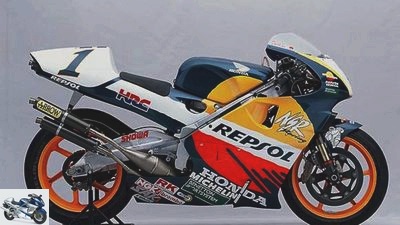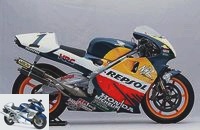Menus

Honda
Comparison test, Honda NSR 500 V, Honda NSR 500
Honda NSR 500 versus Honda NSR 500 V
Do you need four cylinders and more than 190 horses to win, or is two cylinders and 135 hp enough? MOTORRAD employee Manuel Pecino got to the bottom of the question in a direct comparison of the Honda NSR 500 and NSR 500 V.
In recent years, Honda has had the half-liter world championship under control with an iron fist thanks to the sophisticated four-cylinder NSR 500. This season, however, the Japanese company also presented a motorcycle that was technically fundamentally different from the world champion machine. Quite as if the Honda Racing Corporation HRC were presuming to provide attractive competition themselves for lack of real opponents. That Honda sent a V2 machine into battle seems paradoxical, especially since the company dropped the three-cylinder concept in favor of the more powerful V4 engines eleven years ago. But since then the situation has changed radically. “Year after year the differences between 250cc and 500cc were smaller, the lap times got closer and closer”, explains HRC technical director Shigeru Hattori the development of the light and handy 500cc twin, which is now also available as a relatively inexpensive production racer for private drivers. The Grand Prix premiere of the NThe SR 500 V could not have been more spectacular. Factory driver Tadayuki Okada drove to pole position in the first race in Malaysia in 1996, and only one fall prevented him from a podium finish in his first big appearance on the brand new V2 machine. Although Okada later did not perform as spectacularly as in Shah Alam, he still managed to place in the top five in eight Grand Prix and came in seventh. After the World Championship final in Australia, MOTORRAD had the chance to try the dissimilar rivals and my first impression was actually that Honda was going two completely different paths to achieve the same goal. The world that lies between the two motorcycles reveals itself from the first contact. The V4 bike is wide and voluminous and, despite the uniform war paint, completely different from its petite, compact V2 sister. If tanks and windshields have similar dimensions because they have to form an aerodynamic unit with the driver’s head and chest, Okada’s machine is clearly narrower and slimmer from the belt downwards. Expressed in common sizes, 130 kilograms live weight can be seen on the voluminous belly of the V4 machine, while the V2 model with its slim wasp waist only weighs 100 kilograms. This small difference is clearly noticeable on the track. The lightweight reacts clearly faster and more spontaneously to changes of direction and folds fully into an inclined position at the thought of the next bend. In order to be just as nimble with the large V4 machine, the driver has to use his physical strength. The difference in weight can be felt when turning as well as at the apex of a curve. At this moment, the 30 kilograms extra weight of the four-cylinder engine seem to be multiplying. While the V2 reacts almost instinctively to every command when changing direction, the V4 needs the correct body movement to accompany the command. The differences between V4 and V2 are also clear when it comes to the engines. While the four-cylinder appears as the expected giant in terms of power and torque in all situations, the Okada motorcycle bites surprisingly poisonous. Actually, I was expecting an elastic engine, especially powerful in the middle speed range, with a hole-free, even power band up to the maximum speed, as I’m used to from other large-volume two-cylinder engines, but far from it. Theoretically, the usable speed range extends from 6000 to 11000 rpm, but at around 8500 rpm the full thrust sets in very abruptly, which makes a clean driving style and risk-free use of the available power when accelerating out of the box. Okada himself admitted that he would always prefer to drive the motorcycle between 6000 and 8000 rpm. “If it doesn’t come down to a long straight, it doesn’t make much sense to go beyond 8000 tours. The engine turns significantly higher, but the additional power does not outweigh the disadvantages. At lower speeds, the slip on the rear wheel is easier to control, and the front wheel remains on the ground, ”the Japanese explained. Softening the performance of the V2 and keeping the rebellious front wheel on the tarmac was the toughest fight Honda had to fight that year. With a frame geometry that, due to the design, was much closer to the 250 than the conventional 500, wheelies were the order of the day with almost every change of direction and when exiting almost every curve. To correct the birth defect, HRC came up with some ideas. A longer swing arm increased the wheelbase; At the same time, the driver’s seating position has been moved forward to put more weight on the front wheel. As simple as the theory was, the project was difficult in practice because every gram less weight on the rear wheel seriously disrupted the balance of the motorcycle. Okada indicated that not all modifications had the desired effect by far. Compared to the rather nervous, difficult character of the V2 prototype, the mature V4 machines from Doohan and Criville are almost good-natured. Driven by the cracks, the V4-500 turns into a volcano, but in the hands of an ordinary person it behaves astonishingly piously like a lamb. Just as the two-cylinder theoretically rotates up to 11,000 rpm, the four-cylinder oscillates up to 12800 / min. min on. But even Doohan and Criville rarely get the pleasure of savoring the temperament of their fire chair up to this mark. “The power is always available in such abundance on a winding route that you don’t even have to turn the motorcycle off,” says Doohan. “If you turn the engine all the way to the red range in each gear, only the rear wheel begins to spin idle, and that means wasted time.” Doohan’s driving style is to use the torque in the middle range to the full, which does not mean that If necessary, he does not let the engine cheer above the rated speed up to around 13,000 rpm, for example without switching maneuvers between two curves. But the needle on his tachometer usually oscillates between 7500 and 11500 rpm. The power released by the Honda V4 engine is so inexhaustible that you can drive very, very fast even with a gentle driving style. The acceleration – with the machine upright, mind you – is so brilliant that you always arrive at the next braking point much earlier than you think. The fact that the light V2 with its 135 HP will soon become a real alternative to the V4 cannot be foreseen at the current stage of development. Because the dynamic driving qualities of the two-cylinder engine cannot compensate for the superior power of the more than 190 hp V4 racer. Of course, the teams that use a V2 model will try everything to get on the podium or even to win – including HRC, who will be competing again in 1997 with two factory twins. But in-house, says chief technician Shigeru Hattori clearly, the V4 is considered the winning machine, and it will stay that way for the time being.
Buy complete article

Comparison test
Honda NSR 500 versus Honda NSR 500 V
–
€ 2.00
Buy now
Related articles
-
Honda NC 700 S and Yamaha XJ6 ABS in the test
17th photos 1/17 Honda NC 700 S and Yamaha XJ6 ABS in a 48 hp comparison test. 2/17 Honda NC 700 S and Yamaha XJ6…
-
fact top test Honda CBF 600 package deal All-round carefree packages are in ?? not only for summer holidays: With variable ergonomics and very …
-
Top test Honda Deauville (ABS)
Art Top-Test Honda Deauville (ABS) Nice weighting The new Deauville is seven kilograms heavier. But that doesn’t matter. Because in return they …
-
BMW R 1200 R, Triumph Speed Triple and Honda CB 1000 R in comparison test
Bilski 48 pictures Bilski 1/48 Triumph Speed Triple. Bilski 2/48 curve artist. As is typical for Honda, the Honda CB 1000 R also makes it easy for its driver. Thick…
-
Comparison: Honda Bol d’Or versus Hornet 900
Comparison: Honda Bol d ?? Or versus Hornet 900 Zeitreise CB 900 F Bol d ?? Or and Hornet 900 ?? two Honda with the same concept: undisguised and with …
-
Bilski Top-Test Honda Hornet 600 due date Attention! Honda has another perky, angry hornet on offer: the new Hornet 600. It’s stronger …
-
Honda CB 650 F in the top test
29 photos 1/29 2/29 3/29 4/29 Despite normal ground clearance and comfortable…
-
Honda VTR 1000 test V-Lenz Spring is all about the new two-cylinder. In the spotlight: Honda’s VTR 1000 F. You didn’t like to read it, those responsible…
-
BMW F 800 GT, Kawasaki Z 1000 SX and Honda VFR 800 F in the test
fact 44 pictures fact 1/44 fact 2/44 fact 3/44 fact 4/44 fact 5/44 Praise to the diversity: The three test candidates all want the same thing, but are looking for it …
-
Honda VFR 800 F and Honda VFR 1200 F in comparison test
fact 8 pictures fact 1/8 Clear distance: the two V4 engines always separate between 35 and over 50 Newton meters. fact 2/8 Honda built the first …